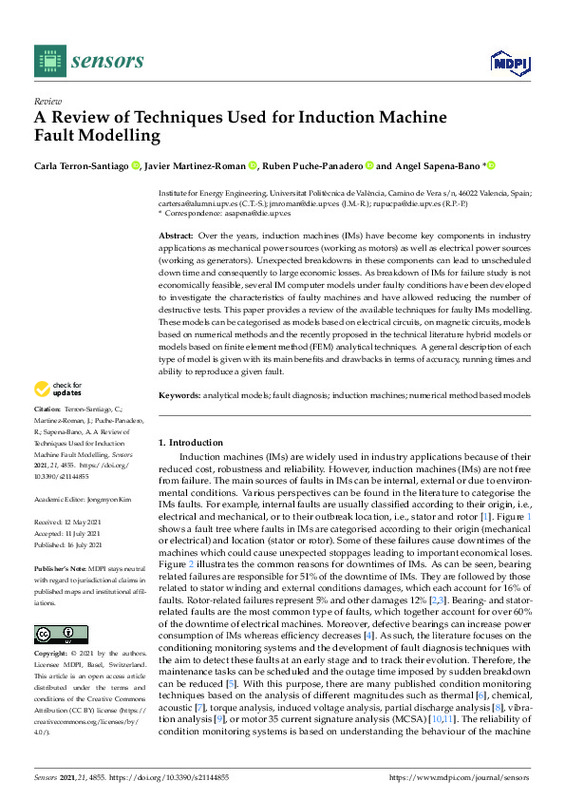JavaScript is disabled for your browser. Some features of this site may not work without it.
Buscar en RiuNet
Listar
Mi cuenta
Estadísticas
Ayuda RiuNet
Admin. UPV
A Review of Techniques Used for Induction Machine Fault Modelling
Mostrar el registro sencillo del ítem
Ficheros en el ítem
| dc.contributor.author | Terrón-Santiago, Carla
|
es_ES |
| dc.contributor.author | Martinez-Roman, Javier
|
es_ES |
| dc.contributor.author | Puche-Panadero, Rubén
|
es_ES |
| dc.contributor.author | Sapena-Bano, Angel
|
es_ES |
| dc.date.accessioned | 2022-02-16T19:03:36Z | |
| dc.date.available | 2022-02-16T19:03:36Z | |
| dc.date.issued | 2021-07-16 | es_ES |
| dc.identifier.uri | http://hdl.handle.net/10251/180898 | |
| dc.description.abstract | [EN] Over the years, induction machines (IMs) have become key components in industry applications as mechanical power sources (working as motors) as well as electrical power sources (working as generators). Unexpected breakdowns in these components can lead to unscheduled down time and consequently to large economic losses. As breakdown of IMs for failure study is not economically feasible, several IM computer models under faulty conditions have been developed to investigate the characteristics of faulty machines and have allowed reducing the number of destructive tests. This paper provides a review of the available techniques for faulty IMs modelling. These models can be categorised as models based on electrical circuits, on magnetic circuits, models based on numerical methods and the recently proposed in the technical literature hybrid models or models based on finite element method (FEM) analytical techniques. A general description of each type of model is given with its main benefits and drawbacks in terms of accuracy, running times and ability to reproduce a given fault | es_ES |
| dc.description.sponsorship | This work was supported by the Spanish "Ministerio de Ciencia, Innovacion y Universidades (MCIU)", the "Agencia Estatal de Investigacion (AEI)" and the "Fondo Europeo de Desarrollo Regional (FEDER)" in the framework of the "Proyectos I+D+i-Retos Investigacion 2018", project reference RTI2018-102175-B-I00 (MCIU/AEI/FEDER, UE) | es_ES |
| dc.language | Inglés | es_ES |
| dc.publisher | MDPI AG | es_ES |
| dc.relation.ispartof | Sensors | es_ES |
| dc.rights | Reconocimiento (by) | es_ES |
| dc.subject | Analytical models | es_ES |
| dc.subject | Fault diagnosis | es_ES |
| dc.subject | Induction machines | es_ES |
| dc.subject | Numerical method based models | es_ES |
| dc.subject.classification | INGENIERIA ELECTRICA | es_ES |
| dc.title | A Review of Techniques Used for Induction Machine Fault Modelling | es_ES |
| dc.type | Artículo | es_ES |
| dc.identifier.doi | 10.3390/s21144855 | es_ES |
| dc.relation.projectID | info:eu-repo/grantAgreement/AEI/Plan Estatal de Investigación Científica y Técnica y de Innovación 2017-2020/RTI2018-102175-B-I00/ES/DISEÑO DE MODELOS AVANZADOS DE SIMULACION DE AEROGENERADORES PARA EL DESARROLLO Y PUESTA A PUNTO DE SISTEMAS DE DIAGNOSTICO DE AVERIAS "ON-LINE"./ | es_ES |
| dc.rights.accessRights | Abierto | es_ES |
| dc.contributor.affiliation | Universitat Politècnica de València. Departamento de Ingeniería Eléctrica - Departament d'Enginyeria Elèctrica | es_ES |
| dc.description.bibliographicCitation | Terrón-Santiago, C.; Martinez-Roman, J.; Puche-Panadero, R.; Sapena-Bano, A. (2021). A Review of Techniques Used for Induction Machine Fault Modelling. Sensors. 21(14):4855-4873. https://doi.org/10.3390/s21144855 | es_ES |
| dc.description.accrualMethod | S | es_ES |
| dc.relation.publisherversion | https://doi.org/10.3390/s21144855 | es_ES |
| dc.description.upvformatpinicio | 4855 | es_ES |
| dc.description.upvformatpfin | 4873 | es_ES |
| dc.type.version | info:eu-repo/semantics/publishedVersion | es_ES |
| dc.description.volume | 21 | es_ES |
| dc.description.issue | 14 | es_ES |
| dc.identifier.eissn | 1424-8220 | es_ES |
| dc.identifier.pmid | 34300593 | es_ES |
| dc.identifier.pmcid | PMC8309924 | es_ES |
| dc.relation.pasarela | S\445742 | es_ES |
| dc.contributor.funder | AGENCIA ESTATAL DE INVESTIGACION | es_ES |
| upv.costeAPC | 2073,03 | es_ES |








